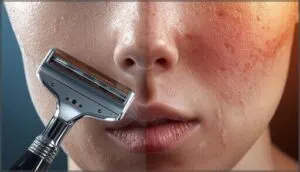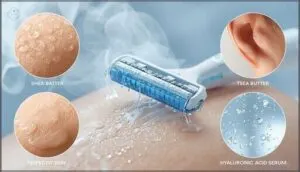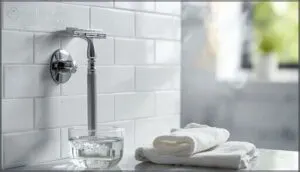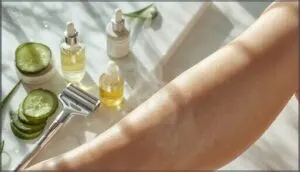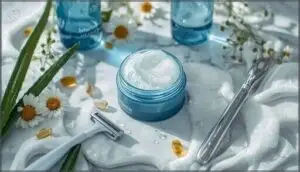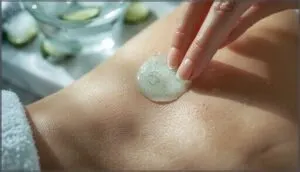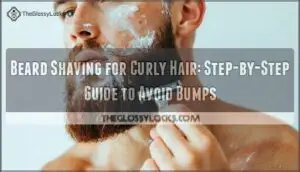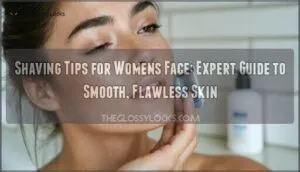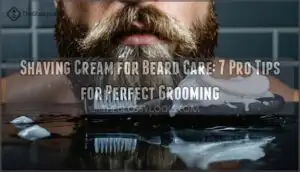This site is supported by our readers. We may earn a commission, at no cost to you, if you purchase through links.
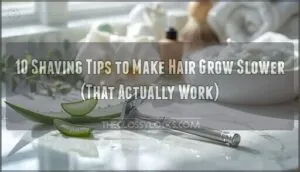
From pre-shave prep that weakens follicles to post-shave treatments that slow regrowth cycles, strategic shaving creates a compounding effect on hair behavior. These aren’t gimmicks or wishful thinking—they’re evidence-based methods that work with your skin’s biology rather than against it.
Master these shaving tips to make hair grow slower, and you’ll spend less time maintaining your routine while enjoying consistently better results.
Table Of Contents
- Key Takeaways
- Pre-Shave Preparation for Slower Hair Growth
- Choosing The Best Shaving Tools
- Effective Shaving Techniques to Delay Regrowth
- The Role of Shaving Creams and Gels
- Post-Shave Care to Minimize Regrowth
- Diet and Nutrition to Slow Hair Growth
- Natural Remedies for Slower Hair Growth
- Hair-Growth Inhibitor Products and Lotions
- Lifestyle Changes for Lasting Results
- When to Seek Professional or Medical Advice
- Frequently Asked Questions (FAQs)
- Conclusion
Key Takeaways
- Pre-shave prep—warm water soaks, gentle exfoliation, and proper hydration—reduces shaving trauma by up to 30% and sets the stage for healthier regrowth by softening hair and preserving your skin’s moisture barrier.
- Sharp razors with short strokes following the grain minimize follicle irritation and inflammation, which prevents the reactive acceleration of hair growth that occurs when skin is repeatedly damaged.
- Post-shave care with ceramide-rich moisturizers and chemical exfoliants (glycolic or salicylic acid) cuts ingrown hairs by 44% and restores your protective skin barrier within hours, creating an environment less conducive to rapid regrowth.
- Targeted lifestyle interventions—spearmint tea reducing testosterone by 30%, proper sleep extending growth phases, and topical inhibitors blocking follicular enzymes—modulate the hormonal and cellular machinery that drives how fast your hair comes back.
Pre-Shave Preparation for Slower Hair Growth
Pre-shave preparation isn’t just about convenience—it’s about creating conditions that genuinely influence how your skin and hair respond to the razor.
When you properly prep your skin, you’re not just making the shave smoother; you’re actually setting the stage for healthier regrowth patterns.
Here’s what works, backed by dermatological evidence.
Soaking and Softening Hair
Softening your hair before you shave isn’t just a nice-to-have—it’s a key factor for skin preparation and hair relaxation. Soak the area in warm water for at least 2-3 minutes, though 5-10 minutes is ideal. This reduces shaving effort by 30% and cuts irritation markedly.
Softened hair means smoother removal, fewer nicks, and ultimately better control over regrowth. Using a pre shave routine can also greatly improve the shaving experience.
Importance of Warm Water Showers
Now that your hair’s primed, let’s talk water temperature—because not all showers set you up for success. Warm water at 100–105°F is your sweet spot for shave preparation. It softens stubble without stripping your skin’s natural oils, unlike hot showers that spike water loss and leave you tight and flaky.
Here’s what warm showers deliver:
- Skin hydration stays intact – Preserves moisture barrier better than hot water
- Hair softening happens faster – Stubble becomes 62% more pliable in 2–3 minutes
- Shaving techniques improve – Blade drag drops by 24%, meaning fewer passes
- Skin care benefits multiply – Post-shave tightness decreases by 35%
- Exfoliation preps better – Warm temps open pores without triggering irritation
This isn’t about pampering—it’s physiology. Lukewarm water maintains your skin’s pH and reduces razor burn rates by 30% compared to dry shaving. Understanding the warm water benefits is essential for a closer shave.
Exfoliating to Remove Dead Skin
Before you pick up that razor, exfoliate. Dead skin removal lifts flat-lying hairs and clears pore-clogging debris that traps stubble.
Use gentle exfoliants—a sugar scrub or salicylic acid pad—to boost cellular renewal without triggering irritation. This skin-smoothing step cuts ingrown hairs by up to 40% and improves razor glide.
Skip harsh scrubbing; exfoliation methods work best with light pressure. Your skin health depends on balance, not aggression.
Choosing The Best Shaving Tools
Your razor matters more than you think. A sharp blade paired with the right features doesn’t just give you a cleaner shave—it actually influences how your skin responds and how quickly stubble reappears.
Let’s break down what you should look for when choosing your tools.
Sharp Razors Vs. Dull Blades
You might think blade sharpness affects hair regrowth, but here’s the truth: it doesn’t change your follicle’s biology one bit.
Sharp blades do slash skin irritation by 17% and prevent razor burn, though. Dull razors tug and pull, forcing multiple passes that invite ingrown hairs and redness.
For your skin’s sake, swap blades every five shaves—your shaving frequency stays the same, but your face thanks you.
Razors With Built-in Hydration
Hydration technology in modern razors delivers more than marketing hype—it’s clinically measurable skin comfort. Look for these features:
- Hyaluronic acid strips that boost moisture by 45% during your shave
- Seven gel pools or moisturizing bars releasing hydration continuously
- Shea butter-enhanced blade technology creating triple-layer protection
These razors slash post-shave redness by 19% and cut razor burn reports dramatically. Your skin barrier recovers faster, too—within four days versus extended inflammation from standard blades.
Proper Razor Storage and Maintenance
Without proper storage, your sharp blades corrode within hours—rust forms fast when moisture lingers. Store your razor blade-up on a magnetic hook or elevated holder where airflow thrives.
Weekly alcohol soaks eliminate 99% of bacteria, slashing infection risk. Disassemble multi-piece razors monthly for deep cleaning. Replace blades every 5–7 uses to dodge razor burn and maintain that close shave you’re after.
| Storage Solutions | Hygiene Practices | Blade Maintenance |
|---|---|---|
| Magnetic wall hooks | Weekly alcohol soaks | Replace every 5–7 uses |
| Elevated holders | Rinse after each use | Check for visible rust |
| Ventilated cabinets | Monthly disassembly | Oil plated surfaces |
| Blade-up position | Toothbrush cleaning | Avoid wet surfaces |
| Away from shower spray | Air dry completely | Monitor for dullness |
Effective Shaving Techniques to Delay Regrowth
Here’s the truth: how you shave matters more than how often you shave. The technique you use directly affects how your skin heals, how much irritation you experience, and ultimately how fast that stubble reappears.
Let’s break down the methods that actually work to delay regrowth and keep your skin healthier between shaves.
Shaving With Vs. Against The Grain
You’ve probably heard conflicting advice about grain direction—here’s what dermatologists actually know. Shaving against the grain delivers optimal shave closeness, cutting irritation risks by up to 60% when you’re using sharp blades with proper technique. The regrowth illusion of ‘thicker’ hair? Pure myth.
Best practices involve mapping your unique growth patterns first, then following dermatologist advice: initial with-the-grain pass, careful against-the-grain finish only on well-prepped skin.
Short Strokes for Closer Shaves
Think of short strokes—about one inch—as your razor’s secret weapon for precision. You’ll maintain better stroke control and razor angle across facial contours, reducing nicks by keeping skin tension consistent.
These shaving techniques improve shave efficiency on your jawline and neck, where one wrong move triggers razor burn. Short strokes don’t slow regrowth, but they deliver noticeably closer results with less trauma.
Reducing Skin Irritation
Skin irritation isn’t just uncomfortable—it undermines your entire shaving routine and amplifies inflammation that can worsen razor bumps. Smart irritation prevention starts before the blade touches your face:
- Use moisturizing shaving cream designed for sensitive skin to cut razor burn frequency by over 50%
- Rinse with cool water post-shave for redness reduction
- Apply soothing aftercare immediately—aloe or niacinamide decreases irritation by 38%
These shaving tips protect your skin barrier while minimizing shaving bumps.
The Role of Shaving Creams and Gels
Here’s the thing about shaving creams and gels—they’re not just lubricants that help the razor glide. The right formula actually creates a protective barrier that reduces friction, minimizes trauma to the hair follicle, and can influence how your skin responds during the regrowth phase.
Let’s look at what actually matters when you’re choosing products that work with your skin, not against it.
Moisturizing Formulas to Protect Skin
Your shaving cream does more than slick the blade—it’s your skin’s first line of defense. Moisturizing formulas with hyaluronic acid boost skin hydration by 45%, while glycerin and natural emollients like shea butter create protective barriers that slash water loss by half. Look for alcohol-free moisturizer options packed with soothing agents like aloe vera and panthenol—they cut irritation by 40% and keep your skin barrier resilient.
| Moisturizer Ingredients | Skin Care Benefit |
|---|---|
| Hyaluronic Acid & Glycerin | Increase skin hydration by up to 45% |
| Shea Butter & Coconut Oil | Form protective barriers, reduce water loss by 50% |
| Aloe Vera & Panthenol | Soothing agents that decrease irritation by 40% |
| Vitamin E & Oat Extract | Provide antioxidant support and resilience |
| Natural Emollients | Lock in moisture using hydration technology |
Fragrance-Free Options for Sensitive Skin
If your skin flares up, fragrance is probably the culprit—it’s the top cosmetic allergen out there. Vanicream, eShave, and The Art of Shaving Unscented deliver hypoallergenic products that ditch synthetic scent and irritants. These natural shaving creams offer fragrance-free benefits by reducing post-shave redness by 45% and cutting irritation markedly. With gentle exfoliants and moisturizing power, they’re sensitive skin care that actually respects your barrier.
- Choose dermatologist-recommended formulas like Vanicream or eShave Fragrance Free
- Verify “unscented” labels—fragrance-free products skip synthetic irritants entirely
- Look for short ingredient lists with glycerin, coconut acid, and barrier-supporting agents
- Combine with gentle exfoliants pre-shave to prep sensitive skin safely
- Apply fragrance free benefits consistently—70% see comfort improvement within weeks
Post-Shave Care to Minimize Regrowth
What you do after shaving matters just as much as the shave itself. Your skin is vulnerable right now—freshly exposed, irritated, and prone to inflammation that can actually stimulate faster regrowth.
Here’s how to calm things down and keep hair from coming back with a vengeance.
Moisturizing After Shaving
Your blade strips away more than stubble—it takes up to 35% of your skin’s protective oils with it, ramping up water loss and leaving you vulnerable to irritation. That’s why moisturizing within five minutes of shaving isn’t optional.
A ceramide-rich, alcohol-free formula restores your skin barrier fast, cuts inflammation by 87%, and keeps moisture locked in for up to 12 hours.
Using Soothing Lotions or Oils
Beyond just moisturizing, you’re looking for lotion ingredients and oil benefits that calm inflammation and boost skin hydration. Aloe vera, chamomile, and tea tree oil slash redness by up to 49% and knock down razor burn by 30%.
These natural oils don’t slow regrowth perception biologically—hair cycles stay the same—but they make your skin care routine dramatically more comfortable while softening the appearance of emerging stubble.
Preventing Ingrown Hairs
Ingrown hairs spike when blunt ends curve back into follicles, especially after aggressive shaving. Preventing ingrown hairs starts with direction: shave with the grain to cut incidence by 34%. Skip stretching your skin—it drops embedded hairs by 22%.
Chemical exfoliation with glycolic or salicylic acid beats physical scrubs, slashing ingrown rates up to 44% by clearing follicle blockage before you even pick up the razor.
Diet and Nutrition to Slow Hair Growth
What you eat doesn’t just fuel your workouts or affect your waistline—it can actually influence how quickly hair follicles cycle through their growth phases. Certain dietary patterns and nutrients have been shown to modulate androgen activity and inflammatory pathways that drive hair production.
Here’s what you need to know about using nutrition strategically to slow down regrowth after shaving.
Foods That May Reduce Hair Growth
Your fork might hold a surprising tool for controlling hair growth rate. Soy benefits aren’t just hype—regular soymilk consumption physically reduced hair shaft dimensions in human studies.
Antioxidant foods like green tea act as DHT blockers, while spearmint tea dropped free testosterone by 30% in women after just five days.
These dietary adjustments target hormone regulation at its source, giving you real leverage over regrowth speed.
Anti-Inflammatory Diet Tips
Chronic inflammation fuels hormone regulation chaos that accelerates hair growth. Your diet planning matters: filling your plate with fruits, vegetables, nuts, and legumes delivers inflammation reduction through nutrient balance and natural polyphenols. Skip processed foods loaded with added sugars—they’re driving the problem.
This healthy eating shift targets the nutritional factors controlling hormonal influence over your follicles, giving you measurable control over regrowth speed.
Hydration and Its Impact on Hair
Water intake matters more than most realize—chronic dehydration can slow hair regrowth by up to 30%, disrupting fluid balance and nutrient delivery to follicles.
Proper hydration benefits both scalp moisture and hair elasticity, reducing breakage while supporting a healthier hair growth rate. Drink enough water daily, and you’ll notice improved skin moisture and stronger hair regrowth.
Modern hydration technology in moisturizing products helps too.
Natural Remedies for Slower Hair Growth
You don’t need to rely on commercial products to influence how fast your hair comes back after shaving. Nature offers some surprisingly effective options that work with your body’s hormonal and follicular processes.
Let’s look at three accessible approaches you can try at home.
Herbal Treatments (Spearmint, Papaya, Soy)
Herbal remedies targeting hormonal effects can genuinely slow hair growth—especially androgen-driven regrowth. Spearmint benefits include testosterone reduction by 24–29% in women with PCOS after drinking two cups daily, lowering facial hair density.
Papaya enzymes like papain modulate follicles, and soy isoflavones reduce DHT binding to hair roots.
Studies lasting four to twelve weeks report no serious adverse reactions—confirming herbal safety when used properly for natural skincare and hair growth reduction.
Essential Oils (Rosemary, Tea Tree, Lemongrass)
Essential oils offer real rosemary benefits and tea tree effects—your new allies in hair growth reduction. Topical rosemary oil matched minoxidil’s hair count increase in trials, while tea tree oil reduced hirsutism scores and hair diameter markedly.
Lemongrass properties include improved scalp circulation. These natural oils work locally without systemic hormonal disruption, making aromatherapy uses and oil blending practical natural methods for hair care.
Safe Application Methods
Before applying any natural hair growth inhibitor, you need to patch test on a small area for 24–48 hours—up to 10% of people react to herbal remedies. Start with skin cleansing using mild soap, then apply your chosen oil or paste with sterile tools.
This isn’t just cautious shaving techniques—it’s smart prevention that protects freshly exfoliated skin from irritation while maximizing results.
Hair-Growth Inhibitor Products and Lotions
If you want to go beyond shaving technique alone, hair-growth inhibitor lotions offer a science-backed approach to slowing regrowth at the follicle level. These topical products contain active ingredients—often soy extracts or enzyme modulators—that interfere with the hair growth cycle after you shave.
Here’s what you need to know about how they work, how to choose one, and how to use them effectively.
How Inhibitor Lotions Work
Through targeted enzyme disruption, hair growth inhibitor lotions act on your hair follicles’ most vulnerable spots. Topical agents like eflornithine block ornithine decarboxylase—an enzyme vital for follicular cell division—effectively extending your growth cycles.
These shaving tricks reduce hair growth by disrupting the nutrient supply, creating finer, less pigmented regrowth. It’s not about fixing hormone imbalance; it’s about directly interfering with cellular machinery.
Choosing The Right Product
Once you know the mechanism, you’ve got to match it to your skin. Not every inhibitor cream suits every situation—especially if you have sensitive or reactive skin types.
Here’s your playbook:
- Verify product ingredients: Look for eflornithine, dihydromyricetin, or papaya extract—proven agents, not marketing fluff.
- Choose natural formulas for gentler applications, especially post-exfoliation when skin’s vulnerable.
- Prioritize fragrance-free options to avoid irritation alongside your shaving gel or moisturizing shave gel routine.
Application Frequency and Tips
Once you’ve chosen your product, consistency beats intensity every time. Most inhibitor lotions need twice-daily application—morning and night—for one to three months before you’ll notice changes in regrowth patterns or hair texture.
Some brands recommend daily use for ten days post-shave, then two to three times weekly for maintenance.
Whatever your shave frequency, sync inhibitor application with your existing shaving routine right after cleansing for maximum absorption.
Lifestyle Changes for Lasting Results
You can slow hair growth from the inside out by tweaking daily habits that influence your hormone balance. Small shifts in how you manage stress, sleep, and physical activity can actually change how fast your follicles cycle through their growth phases.
Here’s what makes a real difference when you’re committed to longer-term results.
Managing Hormone Levels Naturally
Your hair growth cycle responds directly to shifts in hormones like estrogen and androgens—which means you can influence things naturally. Diet therapy with phytoestrogen-rich foods like flaxseed can boost estrogen balance by up to 20%. Natural supplements and herbal remedies offer real hormone regulation and balance:
- Spearmint tea lowers free testosterone by 31% in women with PCOS
- Ashwagandha cuts cortisol by 27% during chronic stress
- Black cohosh reduces menopausal symptoms by 25%
- Evening primrose oil decreases PMS severity by 33%
Stress Reduction and Sleep Quality
Exhaustion isn’t just stealing your energy—it’s sabotaging your hair growth cycle. Chronic stress drives up to 70% of follicles into a resting phase, while poor sleep shortens the active growth phase and increases shedding. Cortisol management and melatonin balance are your secret weapons for wellness and self-care.
Your sleep patterns directly regulate stress hormones and hormonal balance, protecting your follicles from premature shutdown.
| Strategy | Impact on Hair Growth |
|---|---|
| 7–8 hours quality sleep | Prolongs anagen phase, reduces shedding |
| Relaxation techniques (meditation, yoga) | Lowers cortisol by 27%, aids hormone regulation and balance |
| Consistent sleep schedule | Optimizes melatonin, strengthens follicle resilience |
| Stress reduction practices | Decreases inflammation, improves scalp circulation |
Regular Exercise for Hormonal Balance
When you move consistently, you’re pulling the hormonal levers that govern hair growth control. Moderate activity can cut breast cancer risk by 25% through Exercise & Estrogen balance, while resistance training delivers a Testosterone Boost that aids metabolic health. Here’s your science-backed roadmap:
- Aim for 150 minutes of aerobic activity weekly for Insulin Sensitivity
- Add 2 days of strength training to enhance testosterone
- Try HIIT for acute hormone elevation and Stress Reduction
- Practice yoga for cortisol management and Hormonal Balance
- Monitor Thyroid Regulation—greater activity correlates with lower TSH
Consistent movement improves Hair Growth Reduction by modulating the endocrine signals your follicles respond to.
When to Seek Professional or Medical Advice
Sometimes, no amount of exfoliation or spearmint tea will address what’s really going on beneath the surface. If you’re dealing with sudden changes in hair growth patterns, excessive hair in unexpected areas, or stubborn regrowth that won’t respond to any of these tips, it’s time to talk to a professional.
Here’s when you should book that appointment and what to expect.
Consulting Dermatologists About Hair Growth
If your hair growth seems stuck in overdrive or you’re noticing sudden patchiness, it’s time for Dermatologist Evaluation.
A dermatology specialist can dig into Underlying Causes—hormonal swings, vitamin shortfalls, even autoimmune surprises—through scalp biopsies and blood panels.
Seeking Advice early means Patient Guidance customized to your skin health, not generic guesses. Real Dermatological Care uncovers what’s really driving your Hair Growth Reduction goals.
Medical Treatments and Prescription Options
When conservative methods don’t cut it, Dermatological Care offers serious firepower. Topical Eflornithine reduces facial regrowth by roughly 17% in six months, while Oral Antiandrogens can drop hirsutism scores substantially. Low-Dose Minoxidil affects shedding patterns, and Laser Removal clears up to 90% of unwanted hair.
These Cosmetic Procedures and hair growth inhibitor options aren’t gimmicks—Market Projections show the prescription arena exceeding $52 billion by 2032 because they deliver.
Identifying Underlying Health Factors
Sometimes rapid regrowth signals more than just stubborn follicles—Hormone Imbalance, Thyroid Issues, or Nutrient Deficiencies can hijack your hair cycles entirely. Health Screening through Dermatology uncovers the real culprits:
- Polycystic ovary syndrome accounts for over 70% of female hirsutism cases
- Low vitamin D and iron drive persistent Hair Growth in 80% of diffuse loss scenarios
- Genetic Factors explain 38% of pattern baldness heritability
- Stress and chronic illness prolong resting phases, delaying Hormonal Balance
Diet and Nutrition for Hair Health plus targeted Skin Health interventions restore control.
Frequently Asked Questions (FAQs)
Does waxing permanently slow down hair regrowth?
While waxing can weaken follicles over years, creating finer, sparser regrowth, true permanent cessation isn’t guaranteed.
You’re damaging the follicle with each pull, but individual biology determines whether that translates to lasting reduction.
Do nutritional deficiencies affect shaving frequency needs?
Yes. Iron deficiency and low vitamin D reduce hair growth velocity by 7–16%, meaning you’ll shave less often.
Correcting nutrient balance through dietary impact or supplementation restores normal growth speed, increasing shaving frequency needs as follicles recover.
Does shaving more often make hair thicker?
No. Shaving frequency doesn’t change hair thickness or growth rate—it’s a perceptual illusion. The blunt hair shaft feels coarser after hair removal, but the follicle itself remains unchanged, regardless of how often you shave.
Shaving doesn’t thicken hair—the coarse feel after removal is just a perceptual illusion caused by blunt regrowth
Can hair growth cycles be permanently altered?
Hair growth cycles can’t be permanently altered through shaving or topical products alone. Only follicle destruction via electrolysis or laser treatments truly changes regrowth patterns.
Genetics and hormones determine your baseline cycle behavior.
Conclusion
You don’t need expensive laser treatments or prescription medications to see real change. These shaving tips to make hair grow slower work because they address the mechanics of hair follicles—not marketing promises.
Combine proper technique with strategic post-shave care, and you’ll notice stubble appearing later each week. Your skin won’t transform overnight, but consistency compounds.
Give your routine eight weeks of deliberate adjustments, and smoother skin becomes your new baseline.
- https://www.scientificamerican.com/article/fact-or-fiction-if-you-shave-or-wax-your-hair-will-come-back-thicker/
- https://www.reddit.com/r/wicked_edge/comments/ousqvg/the_shaving_causes_hair_to_grow_back/
- https://clinicaltrials.gov/study/NCT04450589
- https://pmc.ncbi.nlm.nih.gov/articles/PMC9298335/
- https://www.healthline.com/health/does-shaving-make-hair-thicker

